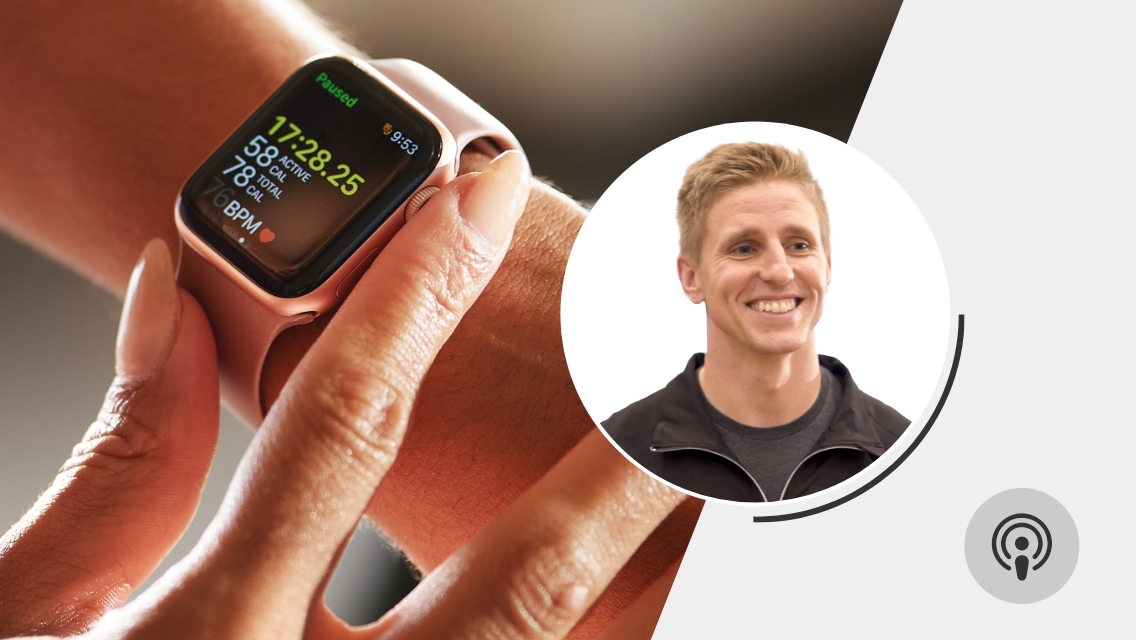No matter where you are on your fitness journey, you’ve likely come across people using wearable devices to monitor their heart rate — whether it be on the fitness floor, in a group-training class that’s targeting certain intensities, or on someone jogging past you. And perhaps you’ve wondered, are those heart-rate monitors worth it? What value does the data provide? Can they really make a difference in your training?
No doubt, we live in a technology-driven society and have more opportunity and choice of gadgets to track our health information than ever before. While some find collecting various forms of objective data such as heart rate, heart-rate variability, menstrual cycle patterns, caloric intake and burn, sleep quantity, step counts, and sedentary time enlightening and informative, others argue that quantifying health to this level of detail is unnecessary.
No matter where your perspective falls on that scale, as it turns out, heart-rate monitoring during exercise — when used correctly — is one metric that can provide immense value to fitness novices, competitive athletes, and everyone in between.
How to Use Heart-Rate Monitoring
Heart-rate monitoring is best utilized in the context of heart-rate “zones,” or customized ranges of various intensities measured in beats per minute (BPM). Most fitness professionals rely on a five-zone heart-rate system, with Zone 1 being the lowest intensity and Zone 5 being the highest intensity. As your intensity increases, you burn more calories per minute, but the percentage of calories you burn from fat declines. In Zones 4 and 5, you’re burning primarily carbohydrate.
An ideal cardio or conditioning program that is well-designed to optimize your metabolism, minimize undue stress on your body, and build your cardiorespiratory fitness ensures that roughly 80 percent of your total conditioning time is spent in Zones 1 and 2 (building your aerobic base), with approximately 20 percent of your total conditioning time spent pushing limits with high-intensity intervals into Zones 3 through 5 (to help increase your overall fitness and VO2 max).
Heart-rate training zones can be roughly estimated manually or by many heart-rate monitors using a calculation, which are both accessible options but can be inaccurate to your specific metabolism. Your zones also can be measured objectively at certain Life Time club locations with an Active Metabolic Assessment™ that uses a mask and medical-grade device to determine your oxygen consumption and carbon dioxide exhalation across various exercise intensities.
Whether you’re using a calculation or targeted data from an Active Metabolic Assessment, once you have your heart-rate zones assessed, a heart-rate monitoring device can then measure your exact beats per minute throughout your workout and help you better understand what zones you are in during your training and how long you’re spending in each.
This information informs you if you need to ramp intensity, decrease it, or change your overall training volume to maximize your health and fitness efforts.
The Benefits of Using a Heart-Rate Monitor
A heart-rate monitor takes the guesswork out of how intensely you’re exercising.
Most people fall into one of two camps: Generally, those who are newer to exercise can overestimate their perceived exertion level (thinking they are working harder than they really are) and don’t have a strong pulse on exercise intensity. This often leads to exercise patterns that provide insufficient challenge, which limits the improvement of overall fitness and the associated health and cardiorespiratory benefits.
On the flip side, cardio junkies who have a long history of exercising and chasing an adrenaline high from constantly pushing their intensity may have trained their bodies to adapt to endure long periods of time in higher heart-rate zones, which burn mostly stored carbohydrate instead of fat, have little impact on body composition, and can contribute to excess stress and adrenal imbalances.
The beauty of heart-rate monitoring is that it can teach you to work smarter, not harder — and by doing so, it saves you time in the long run by making sure you’re getting the desired effect from each and every workout you do. It can dramatically increase your efficiency with the time you carve out of your busy schedule to exercise, particularly if you’ve accurately pinpointed your current heart-rate zones.
Additionally, a heart-rate monitor can inform you as your body changes over time. When you’re able to do more intense exercise with a lower heart rate, or when you notice your heart rate recovering by dropping faster in between high-intensity intervals at the same workloads or speeds, it’s an objective and clear sign that your cardiorespiratory fitness is improving.
Anytime you have hard data showing that your work is paying off, you’re more likely to stick with exercise consistently and keep chasing improvements toward the best and healthiest version of you. It’s a great way to stay motivated.
Types of Heart-Rate Monitors
The technology of heart-rate-monitoring devices is ever-evolving, but there are three common categories of devices you’ll see most often:
Arm Bands
These are convenient and easy to take on and off. One downside is that the technology that many of them use may decrease the accuracy of their data when used on darker skin tones or on those with tattoos in the area it’s placed. If you use an arm band, you’ll want to make sure it has sensor lights in various colors (such as the Scoscho Rhythm) to improve accuracy. They also need to be synced with an external device or app to display your heart rate.
Chest Straps
These are usually considered the most accurate heart-rate monitoring gadgets by some fitness enthusiasts, likely because they’ve been around for a long time. Putting them on is a little less convenient, and most of them can get thrown off if the user is wearing a bra with an underwire. Similar to arm bands, they will typically need to sync with another device to display your heart rate. Life Time’s option is one of the most affordable ones and is compatible with several external trackers and several in-club equipment options.
Watches
Arguably the most popular and convenient device to measure heart rate, this modality offers the most choices depending on the features you’re looking for. Most of them also include the options to measure your resting heart rate, steps, sleep, and even the ability to sync with your phone, including texts and calendar notifications. And while the technology used may not be at the level of precision and accuracy of chest straps and arm bands, there have been massive improvements made over the last decade or so. It’s recommended to find an option that can both match your personal feature needs, as well as program five heart-rate zones into an easy-to-read display on your wrist.
So, are heart-rate monitors really necessary?
Reliance or need for a heart-rate monitor largely depends on your goals and personal definition of “necessary.”
For those who are looking to maximize the impact of every minute they spend exercising and therefore save time, heart-rate-monitoring devices provide a precise method to do so, particularly when using accurate heart-rate zones.
However, if you’re aiming to be active for the sake of being active, with no specific body composition, performance, or health goals in mind, then a device might be interesting, but not needed.
It also may not be best for those who have tendencies to obsess or ruminate over health data or who have a history of an unhealthy preoccupation with calorie burn or other exercise metrics that may add stress or negatively impact your mental health. (Note: Outside of competitive athletes, most people are better off not worrying about calories burned during exercise. Learn more here: “Straight From the Coaches: Your Health & Fitness Questions, Answered”)
One more caveat to note:
If you’re contemplating starting an exercise routine or are just beginning to get consistent, know that exercising regularly — with a heart-rate monitor or not — pays dividends to your health and wellness over being sedentary. Don’t ever let not having a heart-rate monitor stop you from exercising regularly. Just know that, when the time is right for you, using one to shape your routine will only amplify your exercise efforts and their associated benefits.




